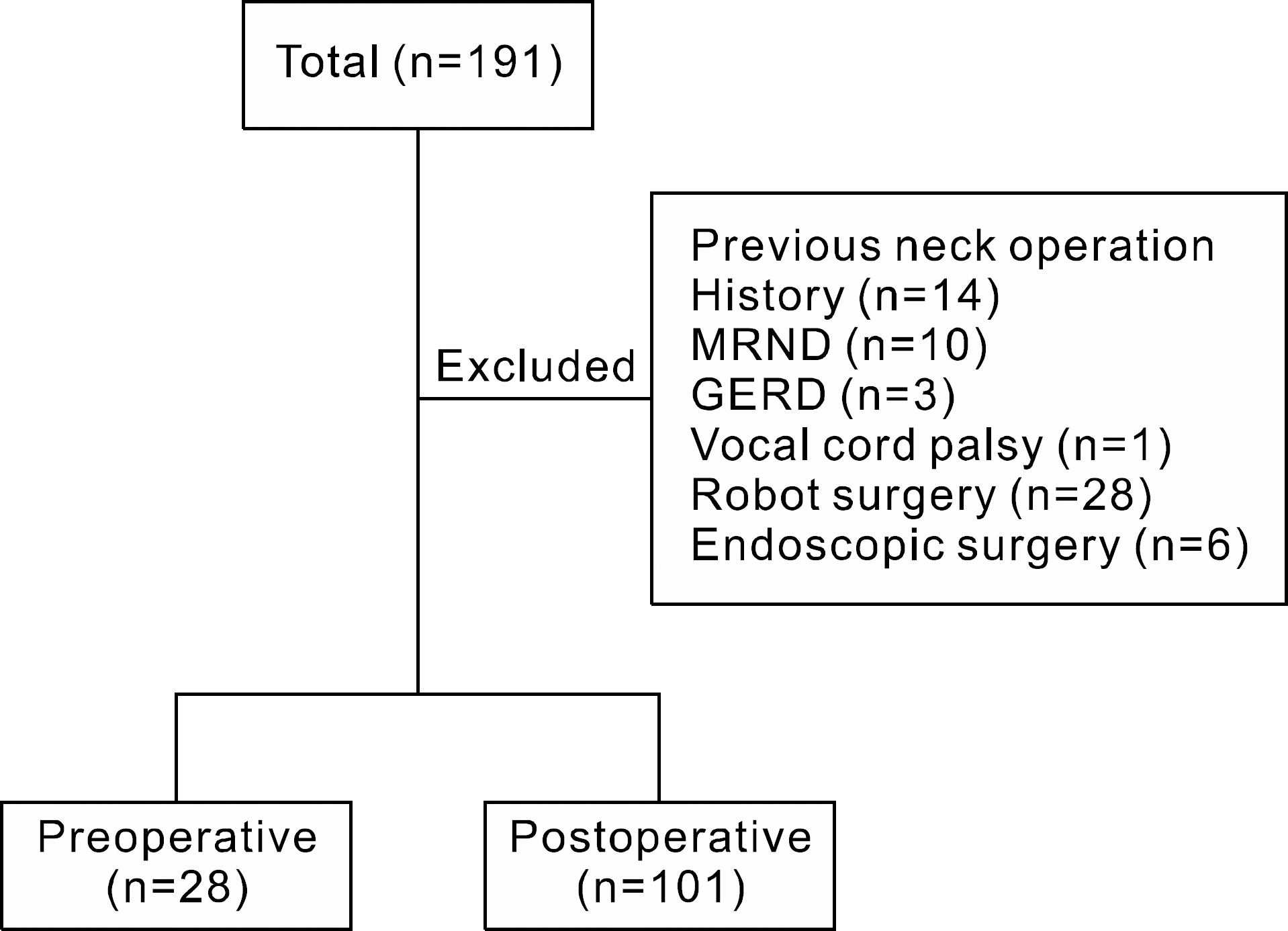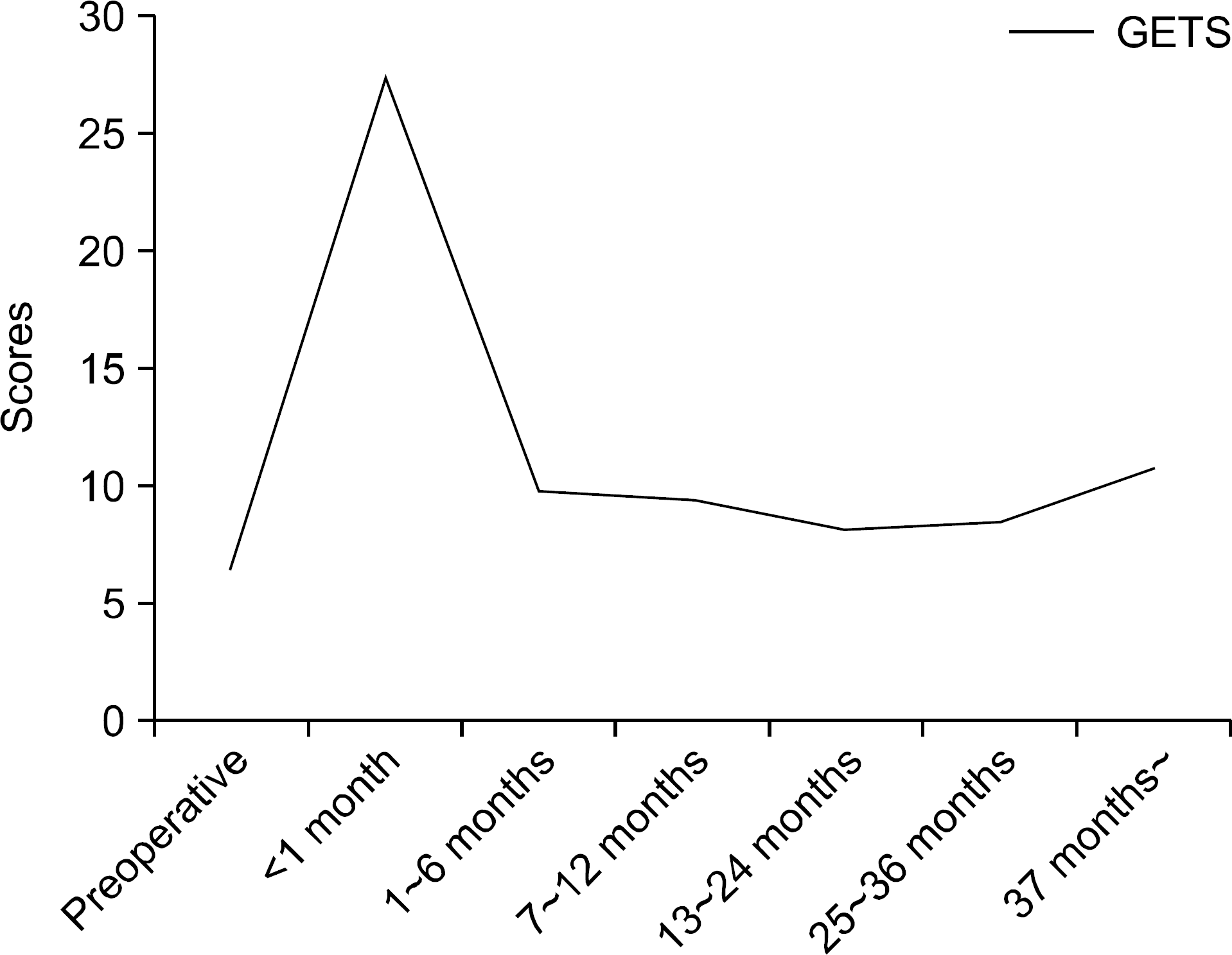Abstract
Purpose
Postoperative adhesion after thyroidectomy results in neck discomfort and swallowing difficulty. However, risk factors for adhesive symptom after thyroidectomy have not been well studied. This study evaluated symptoms related to postoperative adhesion after thyroidectomy.
Methods
The Glasgow-Edinburgh Throat Scale (GETS) questionnaire was used to evaluate postoperative adhesion. Patients who completed the GETS questionnaire either pre- or post- operatively were enrolled. Patient clinical and pathological details including age, gender, body weight, body mass index (BMI), tumor size, thyroid volume, extent of thyroidectomy, postoperative months, and neck thickness on ultrasonography and computed tomography (CT) were abstracted.
Results
Twenty-eight preoperative (22 females, six males) and 101 postoperative (83 females, 18 males) patients were enrolled. The mean age of the pre-operative enrollees was 52.1±11.7, and of post-operative enrollees 51.8±12.4 years. Patients who were within one month post-surgery had higher GETS scores than preoperative patients (27.4±20.1 vs. 6.5±11.1, P<0.001). Two months after surgery, GETS scores of postoperative patients did not differ significantly from the scores of the preoperative patients. There were no significant associations between clinical and pathologic features (age, tumor size, BMI, neck thickness on ultrasonography and CT) and GETS scores.
Conclusion
Postoperative adhesive symptoms were most severe at one month after surgery, while questionnaire scores two months after surgery were comparable with preoperative patients. Further studies will be required for better understanding of the natural course of postoperative adhesion after thyroidectomy.
Go to : 
References
3. Lombardi CP, Raffaelli M, De Crea C, D'Alatri L, Maccora D, Marchese MR, et al. Long-term outcome of functional postthyroidectomy voice and swallowing symptoms. Surgery. 2009; 146:1174–81.

4. Lombardi CP, Raffaelli M, D'alatri L, De Crea C, Marchese MR, Maccora D, et al. Video-assisted thyroidectomy significantly reduces the risk of early postthyroidectomy voice and swallowing symptoms. World J Surg. 2008; 32:693–700.

5. Pereira JA, Girvent M, Sancho JJ, Parada C, Sitges-Serra A. Prevalence of longterm upper aerodigestive symptoms after uncomplicated bilateral thyroidectomy. Surgery. 2003; 133:318–22.

6. Stojadinovic A, Shaha AR, Orlikoff RF, Nissan A, Kornak MF, Singh B, et al. Prospective functional voice assessment in patients undergoing thyroid surgery. Ann Surg. 2002; 236:823–32.

7. Deary IJ, Wilson JA, Harris MB, MacDougall G. Globus pharyngis: development of a symptom assessment scale. J Psychosom Res. 1995; 39:203–13.

8. Consorti F, Mancuso R, Mingarelli V, Pretore E, Antonaci A. Frequency and severity of globus pharyngeus symptoms in patients undergoing thyroidectomy: a pre-post short term cross-sectional study. BMC Surg. 2015; 15:53.

9. Maung KH, Hayworth D, Nix PA, Atkin SL, England RJ. Thyroidectomy does not cause globus pattern symptoms. J Laryngol Otol. 2005; 119:973–5.

10. Holler T, Anderson J. Prevalence of voice & swallowing complaints in Pre-operative thyroidectomy patients: a prospective cohort study. J Otolaryngol Head Neck Surg. 2014; 43:28.

11. Walgenbach S, Junginger T. [Is the timing of completion thyroidectomy for differentiated thyroid carcinoma prognostic significant?]. Zentralbl Chir. 2002; 127:435–8.
Go to : 
 | Fig. 1.Distribution of the patients included in the study. MRND = Modified radical neck dissection; GERD = Gastroesophageal reflux disease. |
 | Fig. 2.The change of Glasgow-Edinburgh Throat Scale (GETS) scores according to postoperative period. |
Table 1.
The Glasgow-Edinburgh Throat Scale (GETS) questionnaire
Table 2.
Demographics and clinicopathologic characteristics of patients who underwent thyroidectomy
Table 3.
Glasgow-Edinburgh Throat Scale (GETS) score according to postoperative period
| Evaluation time | n | GETS | P |
|---|---|---|---|
| Preop | 28 | 6.5 | − |
| <1 month | 11 | 27.36 | 0.000* |
| 1∼6 months | 37 | 9.78 | 0.101* |
| 7∼12 months | 14 | 9.36 | 0.249* |
| 13∼24 months | 12 | 8.17 | 0.130* |
| 25∼36 months | 15 | 8.47 | 0.917* |
| 37 months∼ | 12 | 10.75 | 0.493* |
Table 4.
Association of clinicopathological features with Glasgow-Edinburgh Throat Scale score according to postoperative follow-up period




 PDF
PDF ePub
ePub Citation
Citation Print
Print


 XML Download
XML Download